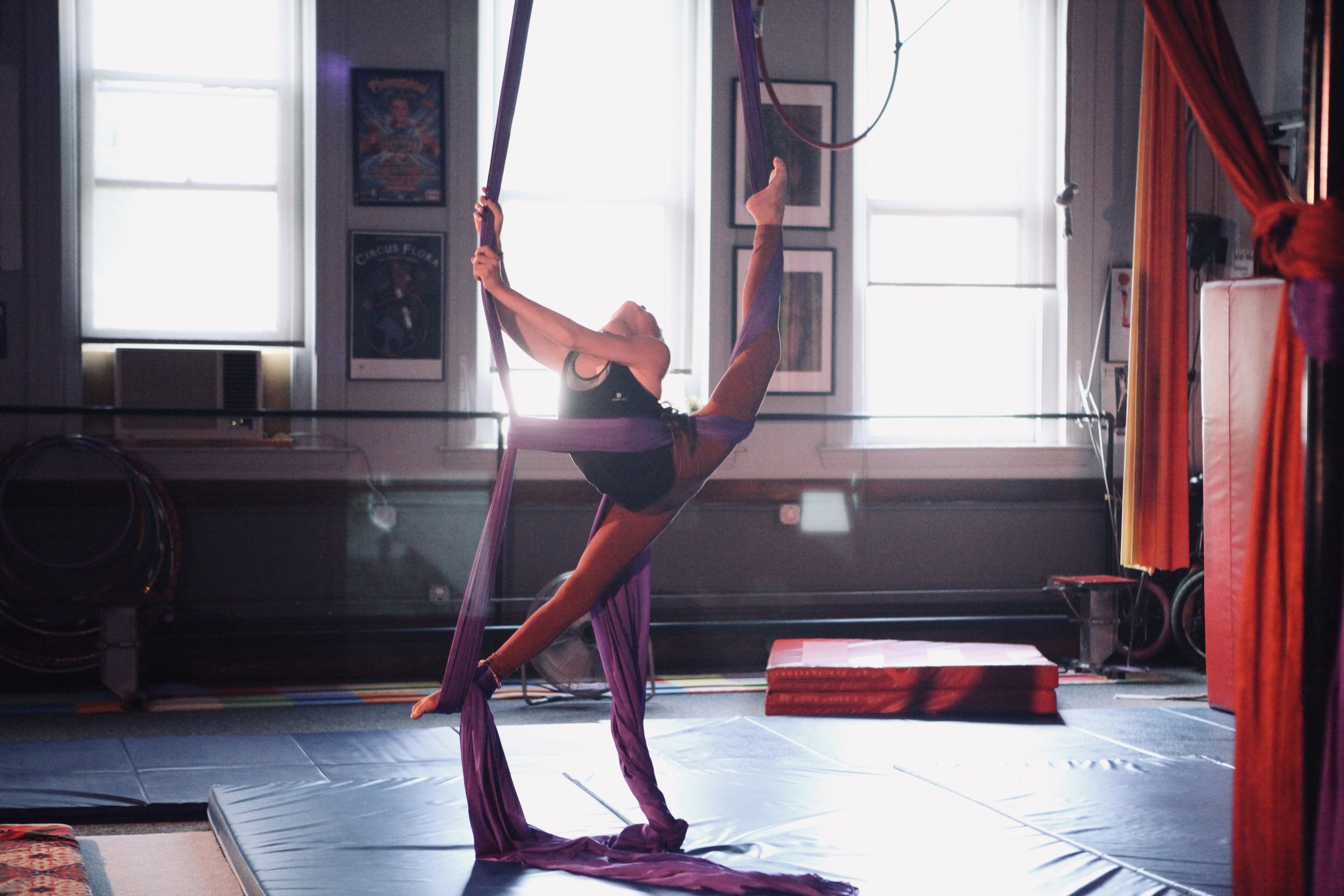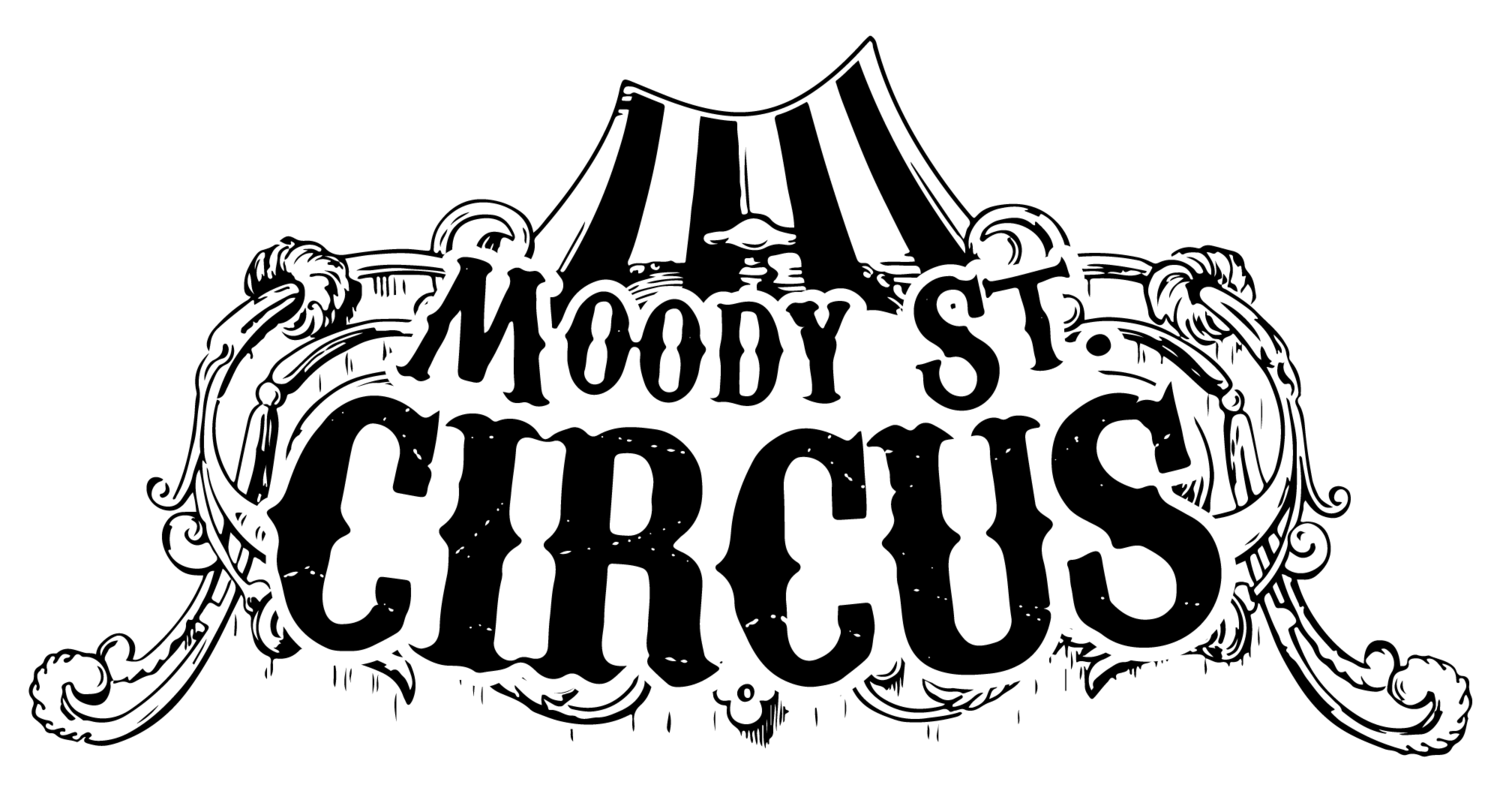
Resources
-
What you wear to circus class is a matter of safety, proper focus on skills and technique, and injury prevention.
No jewelry, buttons or zippers on clothing is allowed on equipment.
Ideally your circus outfit will be tight leggings that cover the backs of your knees (but do not cover your feet) with a leotard or tank top (that won’t move!) when you flip upside-down! If you are wearing a tank top or leotard that does not cover your arm pits you may want to have a tight fitting tee which covers your armpits to put on to execute some skills. Clothes should be form-fitting so that nothing will get twisted up in the silks or equipment! Form fitting clothing keeps you safe, encourages good technique and minimizes distractions.
You can buy a leotard for under $20, available online at Discount Dance Supply and many other local dance stores. Dancer’s Image in Newton. Capezio in Wellesley. We also recommend buying inexpensive tights and cutting off the feet to wear as leggings. You do not have to spend a lot of money on this. Since we do so much barefoot work in the studio, clipping your toe nails and keeping your feet clean helps keep our equipment stay clean and our aerial fabric without snags and holes.
-
Belly Dance Classes are conducted barefoot or with dance paws if you prefer. No street-shoes allowed.
Wear comfortable workout-like yoga attire you can dance and sweat in.
Hip-scarves, finger cymbals, veils and tambourines are all provided for in-class use.
You only need to bring yourself and your smiling hearts!
-
Here are some of our favorite at-home workouts that will help you in your circus journey!
#1 Our top choice of at-home workout for any aerialist is getting a pull up bar! You can practice let downs and shoulder shrugs to build up to your first pull up - as well as do a lot of hanging core exercises to help build core and hip flexor strength which are so important for strong lines and circus skills.
#2 Core workouts! You can find some of our MSC core classes ranging from 3-20 minutes on our VIMEO page. We also are big fans of Cirque du Soleil performer Elizabeth Williams’ workouts which you can find here on this page.
#3 Cross Train! Find another activity you enjoy. Many of our. students also practice rock climbing, dance, pilates, boxing, running, and various other activities!
-
*Please note we are not associated with these companies in any way other than being happy customers.
CIRCUS:
* NYC based Brian Dubé is always a good place to start your search for juggling and object manipulation items.
* We liked to start our circus kids on their plate spinning journey with Mister Babache flexible spinning plates - they are somewhat softer than hard plastic spinning plates and great to learn on.
We have found them at:
For at home training pull up bars are amazing. It can also be helpful to have a few yoga blocks on hand. Yoga blocks can be found at your local target/TJ maxx/ Marshalls.
If your doorways are not conducive to installing a pull up bar, we have found the company Base Blocks makes similar freestanding structures.
* Post COVID-19, everyone who likes grip aid needs to have their own bottle of sticky spray. We no longer offer bottles for communal use. You can find Tuf-Skin spray, made by Cramer, on amazon and also on the Aerial Essentials website.
* Belly Dance Resources can be found on Melina’s Tips From The Hip instagram page.
-
Open studio sessions are by invitation only.
Typically invitations are given to students who
* are actively/regularly attending classes
* have demonstrated good instincts and habits in skill practice that we can trust will be maintained in independent practice.
* have registered for a private lesson to talk about limits and setting goals!
What we look for: listening to your body, resting when your grip is struggling or tired, not taking chances, understanding safe resting poses in the air, being able to maneuver slowly through sequences/skills, ability to remember wraps.
Safety is our top top priority, especially as we get to know new students in this new setting and circumstance!
-
*Please note we are not affiliated with these companies in any way other than being happy customers!
Please remember that zippers, buttons, and jewelry can be very damaging to our equipment.
-
We are so thrilled when our students fall so in love with aerial arts that they want to practice every. single. day - (as long as that practice goes hand in hand with a thorough warm up and strengthening and conditioning drills!)
However, DON’T COMPROMISE SAFETY FOR YOUR FUN!
Aerial arts are a VERY dangerous practice. They require body awareness, control (ability to hold positions and move through pathways with respect for transitions), strength built through good form habits learned in classes and lessons with a qualified coach.
Truly the best way to work at home towards becoming a great circus artist is through strength training of the entire body - most especially abs and arms - and installing a simple pull up bar can do the trick. You can always add climbing straps purchased from a mountain climbing store to the pull up bar to work that vertical grip and safely train (always with mats underneath)!
We cannot recommend that any youth or beginner circus arts student have an aerial rig at home for liability reasons. It is very important that wraps be remembered and executed correctly in order to keep the body safe. Most youth (and beginner) students require repetition and the watchful trained eye of a coach by their side in order for these movements to be absorbed and ingrained into their body’s memory. When you begin your practice alone at home it can be difficult to unlearn the bad habits that are created when you do return to a class. Learning from online resources is great when accompanied by hands-on coaching - there are many nuances to aerial wraps and positioning, engagement or control of the body that are difficult to understand the reasoning or importantce behind them. Skills are best ”unwrapped” with a coach at your side!
Working through new or not-yet perfected skills on your own can be detrimental to your studio aerial practice as you would then potentially have to unlearn bad habits and sloppy form. Working through skills you do not yet have the strength or flexibility for is potentially detrimental to both your progression and your body. The content taught in aerial arts class is very specific and purposeful - classes are designed to match the level and ability of the student which is why foundations and pre-requisites are so important.
Strength and proper form are safety issues!
If you are still eager to train at home - do your research! Do not buy from Amazon and do not hang from trees! Have an open and honest conversation with your coaches - hear their opinion and reasoning behind why a home rig may or may not be the best option for you.
As always:
TRAIN, CONDITION, AND FLY safely and with proper form.
